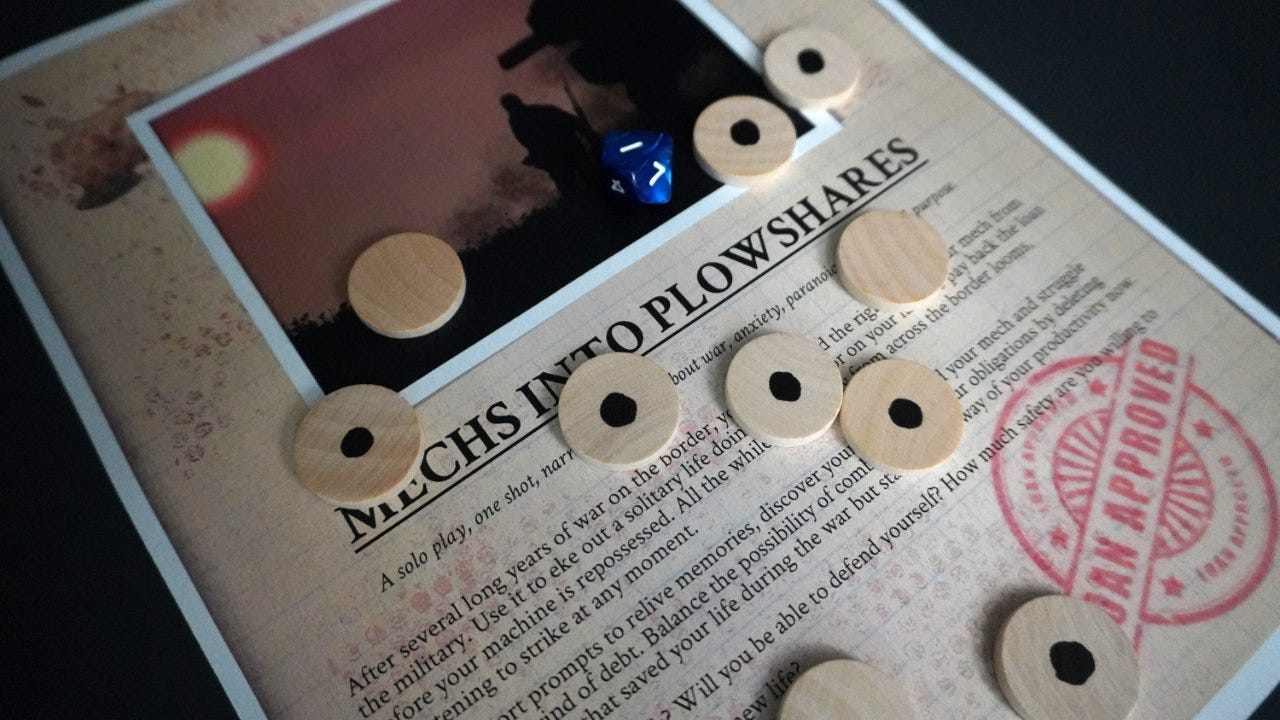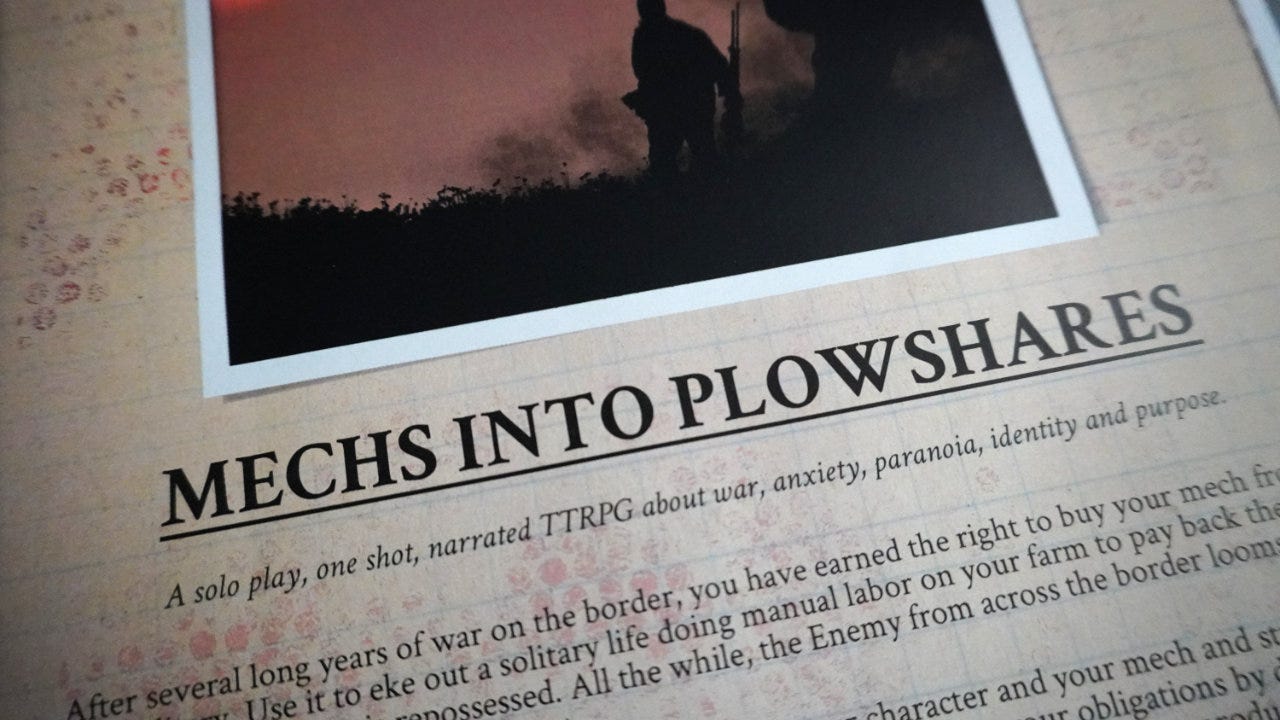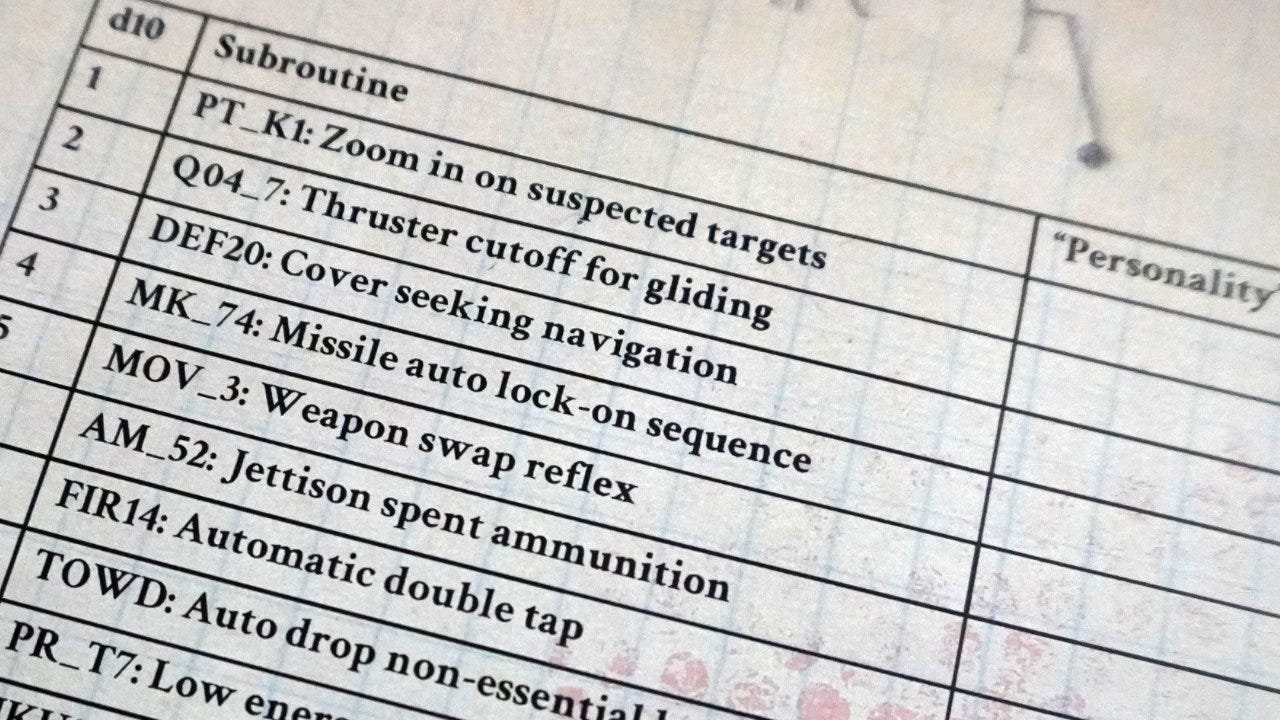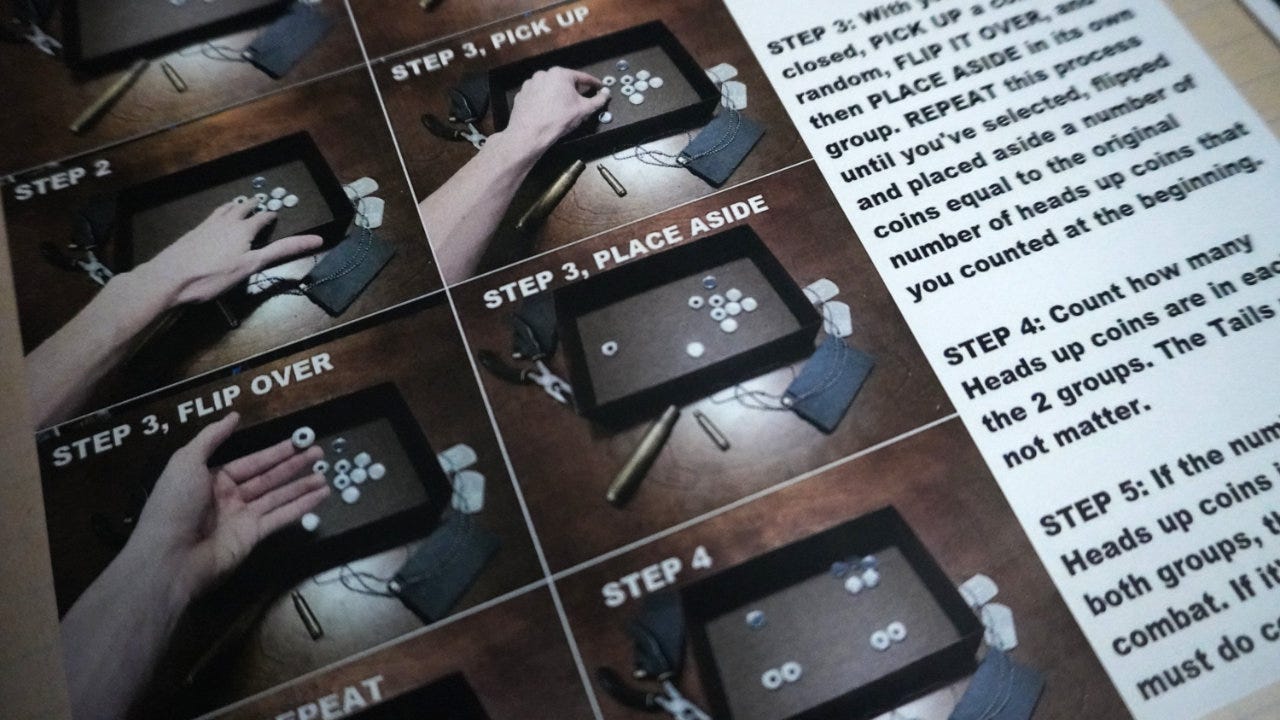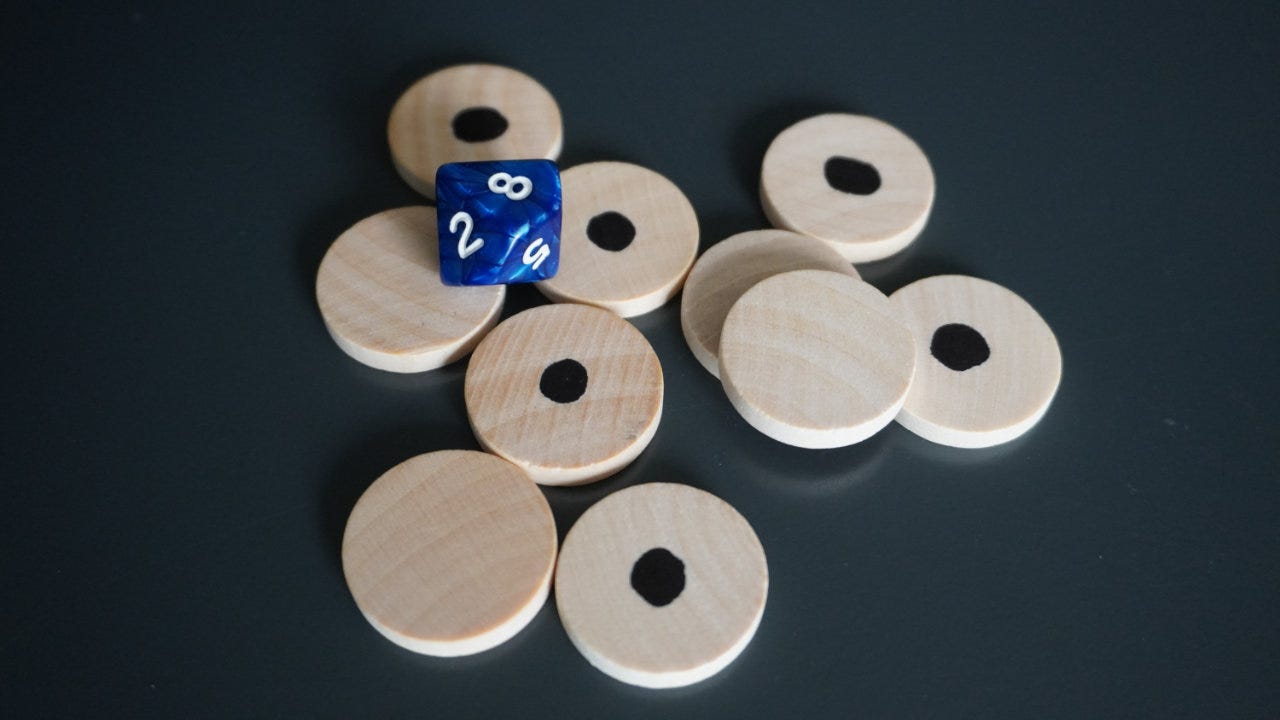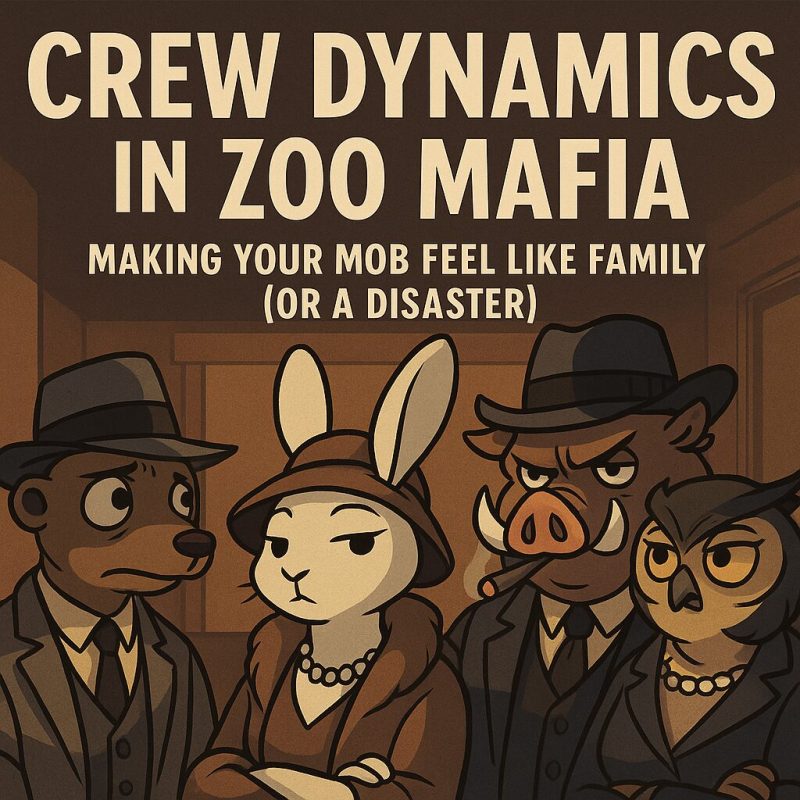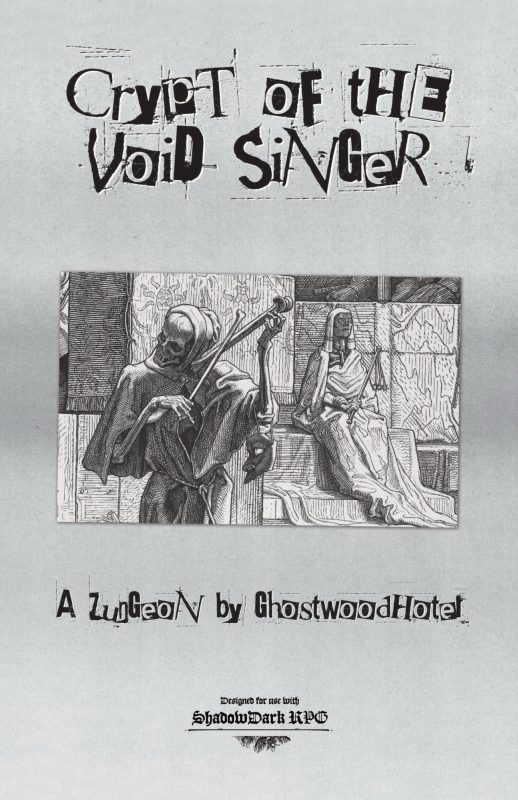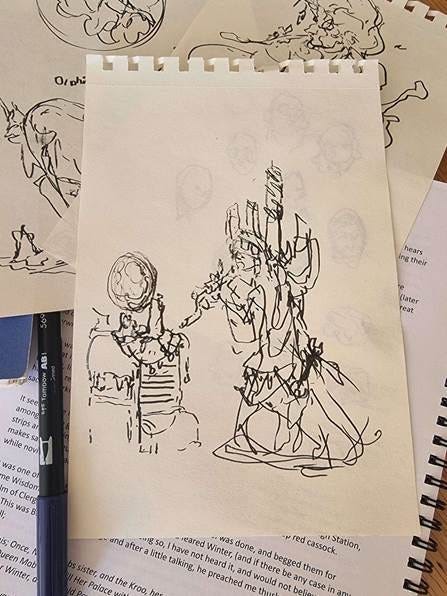SMOOSH JUICE
Playing the Chaplain’s Game
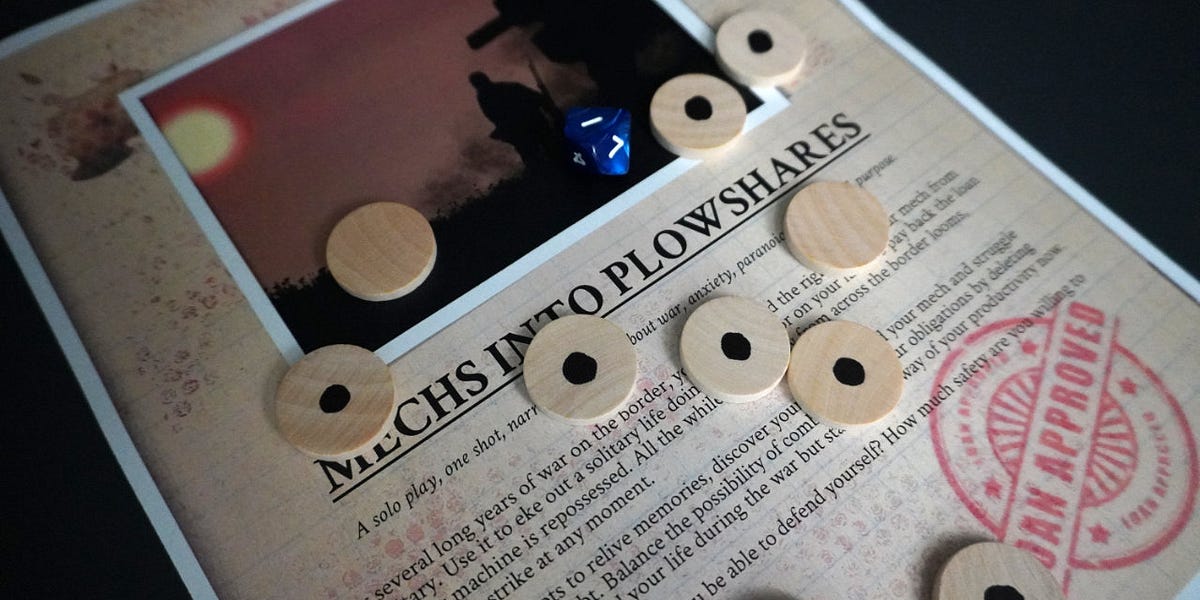
Last week we looked at how Menagerie of the Void uses index cards in an interesting way to tell the story of a sad space zoo. This week we are looking at another solo TTRPG — Mechs Into Plowshares. Specifically, how it uses a coin-flipping mini-game as a resolution mechanism.
This article contains spoilers, but I’ll warn you before they show up.
Mechs into Plowshares by Anomalous Entertainment is a solo journaling TTRPG about farming with the ever-present threat of an enemy attack.1
Here is the introduction:
After several long years of war on the border, you have earned the right to buy your mech from the military. Use it to eke out a solitary life doing manual labor on your farm to pay back the loan before your machine is repossessed. All the while, the Enemy from across the border looms, threatening to strike at any moment.
Notably, the game doesn’t have a standard core game loop.2 Instead it is a linear narrative consisting of ten weeks. Each week is played in order, each with it’s own set of instructions.
In Week 1, you think about your name, who you fought for, and who is the enemy. Subsequent weeks build the story of your life on the farm, struggling to make enough payments — wondering if supplies will come. You’ll think about the people you saved and how your family was impacted.
At times you’ll flip a coin to determine what happens in the game. A caravan of trucks rumbles down the road — heads it’s supplies for you, tails and it’s supplies for the enemy.
The entire game takes place over ten weeks.
Your mech is made for combat, but you can modify it to be better at farming:
Right now you have all of your combat subroutines, but you will be given the chance to erase them and cross them out later. If and when you are forced to enter combat, roll on the subroutine chart. If you roll a combat subroutine, you survive. If you roll a crossed out subroutine, you die; describe how you’re machine is destroyed and say your final words.
Ten subroutines in all, ranging from target acquisition to low-energy rest mode. At the start of the game, all the subroutines are made for combat. You can change that, however, by crossing them off throughout the game. Converting your killer mech into an agricultural machine.3
Throughout the game you’ll be forced to roll (d10) on the chart of subroutines. If it’s a farming activity, you’ll want to roll a crossed-out subroutine (i.e. one that has been converted to farming). But when the enemy arrives, you’ll need to roll on one that has not been crossed-out (i.e. a combat system) or die.
There are points in the game when you can cross out up to five of the subroutines at a time. Each one crossed-out will permanently erase part of your combat ability — with the thread of enemy combat looming.
The game asks: How much safety are you willing to sacrifice to make your new life?
Fortunately the Chaplain’s Game can help you know when the enemy will attack:
The Chaplain noticed that the soldiers would keep track of supply movements with coins. The commander always said that it was useless, there was no way to know where they were going. We wouldn’t stop. It made us nervous to see the trucks coming and going.
Here’s how this game within a game works using about 10 coins:
-
Gather all the coins on the table and count the number of heads.
-
Close your eyes and mix the coins around.
-
With eyes closed, pick up and flip a number of coins equal to the number of heads in the original group of coins, placing them into a separate group.
-
Count the number of heads in each of the two groups.
-
If the number of heads is equal, there will be no combat. If it is not equal, there will be combat.
You start with a small number of coins on the table, but will gradually add to this over time. At pivotal points in the game (e.g. Week 4), you are instructed to play the Chaplain’s Game to see if the enemy attacks.
If the attack comes and combat is required, you’ll need to roll a d10 and hope you hit one of your working combat systems (i.e. not crossed-off). Otherwise it will be destruction and a quick end.
Will the enemy come? It’s up to the Chaplain’s Game.
And the Chaplain’s Game is always right.
SPOILERS AHEAD
The following contains major spoilers for Mechs into Plowshares. If you plan to try the game, I strongly suggest you do so before reading the rest of this article. You have been warned.
When I first tried Mechs into Plowshares, I was fascinated (and a little confused) by the Chaplain’s Game. Why did it seem like such a complicated way to get a binary (i.e. yes/no) answer out of a game? Surely you could just roll a die instead? Why use a method that required so much explanation?
This caused me to look into the probability of combat happening or not using this method. Was it just 50/50 and could be done with a coin flip? Or was there something more subtle going on?
Having watched Jake Vanderplas’ Statistics for Hackers, my first method was, of course, to directly simulate the Chaplain’s Game in Python. A few lines of code later, and I was able to generate some results:
No combat! Some good luck. So I ran it again. And again. And again.
Every single time…. no combat. The number of heads was always equal. Surely I did something wrong! So I checked the code. And then pulled out some actual coins to try it… same results. Always an equal number of heads in both piles.
The enemy never arrived. There would be no combat.
After briefly thinking the game was broken, I noticed the following written at the end of Week 9:
It was funny. They told you that the rules were different on the front than the way you played back home. If the Enemy won the Chaplain’s Game, you must do combat. There, if you put the same number of Heads up coins in each pile, it meant the enemy would attack you. But here, in peace time, if you got the same number of Heads in each pile, it meant that you were safe.
The Chaplain’s Game is always right.
Play the Chaplain’s Game, but keep your eyes open. Play it again until you understand.
I finally understood.
Major spoilers continue in the next section!
The Chaplain’s Game is designed with the appearance of randomness, but in practice the result will always be the same. By taking a number of coins equal to the number of heads and flipping each one, you are guaranteed to have an equal number of heads when you are done. The enemy will never come. Combat will never happen.
Somehow Mechs into Plowshares expertly creates a system (a ritual if you will) that the player does throughout the game. The player is primed to believe that there is an unseen enemy that could attack at any time. They are told that the Chaplain’s Game is the divination method. Close your eyes. Shuffle and flip coins. Somatic components that create the spell of the game.
But the Chaplain understood that the soldiers need a sense of control and stability in times of war… and in times of peace. The Chaplain’s Game could be played over and over until the player (i.e. soldier) realizes the war is over.
In an ironic twist, the optimal move in the game is to cross-out as many mech combat subroutines as you can as early as you can. You’ll never need them. You’ll be better off being converted into a high-tech harvester than remain a war machine. But you aren’t told that… you need to learn it through repetition.
The player and the player’s character come to this realization at the same time.4
The Chaplain knew what to do.
It’s hard to design good, novel, thematic tabletop game mechanisms. That’s why it’s easy to write about them every week!
What I hadn’t considered until now was how hard it would be to design a mechanism that appears to have a randomized output, and yet actually yields the same result every time. In many ways it’s easy to make a new roll over or roll under system or design some opposed rolls. Tricking seasoned players into thinking there is a chance of combat, when there is none… that is no small task!
Granted, this might be a one-time trick. Once you realize the conceit, the game has limited replayability.
But what a memorable and thematic experience it creates!
Some things to think about:
-
Loop-less games might exist: Mechs Into Plowshares is a good example of a linear game that progresses through stages (i.e. weeks) and never repeats. While some of the fundamental mechanisms are reused (e.g. flipping coins), it doesn’t feel like being locked into a core game loop.
-
Games within games: The Chaplain’s Game is a diegetic game within Mechs Into Plowshares — a game specifically designed by the Chaplain to calm nervous troops. As such, it is both a resolution mini-game and Layer 1 Core Gameplay, creating an immersive experience.
-
Tricking the player: At first, I believed what I was told… the Chaplain’s game could give one of two results. It fit the narrative of the game and I had no reason to be skeptical. But even after questioning the results and simulating it in Python, I still believed I must be doing something wrong — not that the game lied! It is a good lesson in cognitive dissonance.
Have you ever seen something like this in other games? I certainly haven’t! If you have any other examples, please let me know in the comments!
— E.P. 💀
P.S. I’m running a free, in-person Make Your Own One-Page RPG class at Bosler Memorial Library starting May 1. Registration is open now!
Skeleton Code Machine is a production of Exeunt Press. All previous posts are in the Archive on the web. Subscribe to TUMULUS to get more design inspiration. If you want to see what else is happening at Exeunt Press, check out the Exeunt Omnes newsletter.

